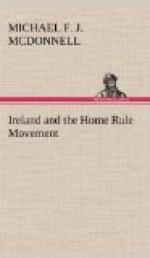With the introduction of the Bill in 1869 began those dire prophecies and grim forebodings which have formed a running accompaniment to every Irish reform, and Mr. Gladstone and the Liberals were denounced for having sanctioned sacrilege. In the end the Church saved from the burning more than in any equitable sense she was entitled to claim. The Representative Body, which was incorporated in 1870, received about nine millions for commuted salaries, half a million in lieu of private endowments, and another three-quarters of a million was handed over to lay patrons.
The commutation paid to the Non-Conformists for the Regium Donum and other payments was nearly L800,000, and in lieu of the Maynooth grant the Catholic Church received less than L400,000, the income from which fund only covers about one-third of the annual cost of maintenance of Maynooth. The history of this grant dates from the L9,000 given to the College by the Irish Parliament, which was increased by Peel in 1844 to L26,000 a year. When in the following year he brought in a Bill to make it a vote of,L30,000 for building purposes, the Times, according to Greville, “kept pegging away at Peel in a series of articles as mischievous as malignity could make them, and by far the most disgraceful that have ever appeared on a political subject in any public journal.”
That on the purely financial side the Catholic Church in Ireland would have gained by concurrent endowment these figures, which represent the whole of her receipts from public funds, amply bear witness, but that she gained in a moral sense far more than in a material sense she might have secured, no one will for one moment deny.
The glaring discrepancy between the amount of public funds at her disposal and the amount held by the other religious bodies from public sources did not abate the virulence with which the Church Act was assailed, but at this day what is of interest is that the jeremiads of the Protestants as to the consequences either to the country at large or to their Church in particular were in every respect uncalled for, as was acknowledged by no less a person than Lord Plunket, at a later time Archbishop of Dublin, who, when in that position, admitted that the Church Act had proved not a curse, as was expected, but a blessing to the Episcopalian Protestant Church. This body has at the present moment in Ireland 1,500 churches, to which 1,600 clergy minister, and as the population of that sect amounts to very little more than half a million it appears that there is one parson for every 363 parishioners, 800 Presbyterian ministers serve nearly a half million of people in the proportion of one for every 554 of that communion. 250 Methodist ministers are sufficient for 62,000 people in the ratio of one for every 248, and the 3,711 Catholic priests, who serve nearly four million of souls, are in the proportion of one for every 891, while in England the priests of the same communion




